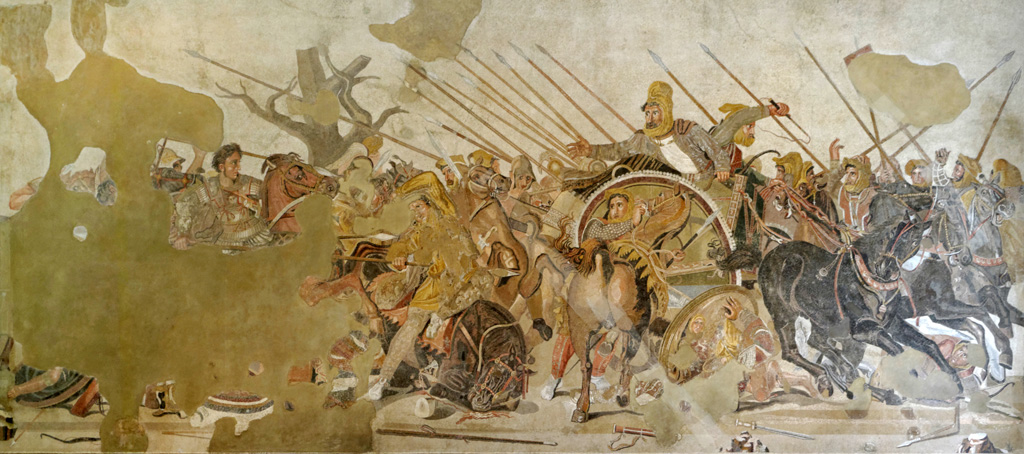The Alexander Mosaic, as well as other later artistic and experimental evidence, shows that the visual conventions of writing affect art. The Alexander Mosaic was found in a house buried in Pompeii in 79 GC when Mount Vesuvius erupted. The mosaic is probably a copy of a painting that Philoxenos of Eretria made about 310 BGC. It shows Alexander the Great, wearing on his breast an image of Medusa, leading his army in a rout of the army of Darius III of Persia. The mosaic’s macro structure is linear, like written text. Moreover, the action depicted moves from left to right, like the typical direction of Hellenistic Greek text.
The Warka Vase provides an even earlier example of writing’s influence on art. The vase was made in the ancient Mesopotamian city of Uruk about 3,200-3,000 BGC. Hence it was created at the same time and place in which writing developed in Mesopotamia. The vase has in carved relief five horizontal registers. The lowest register represents water. The next higher register has a regular pattern of barley and palm plants. Then comes a register of alternating rams and ewes facing right. Above that is a register of nude men carrying baskets of goods to the left. The top register shows the male ruler, proceeded by another nude male carrying a basket of goods, moving to the right to meet a female figure. The female figure is associated with the goddess Inanna. The ancient Mesopotamian text Inanna and Enki declares, “her genitals were remarkable. …… her genitals were remarkable. She praised herself, full of delight at her genitals.” Scholars thus interpret the Warka Vase as representing and explaining the sex-based distribution of goods in both ancient and modern societies.
The Warka Vase’s composition shares many features with early Mesopotamian writing (images of vase). Early Mesopotamian writing consisted of impressed tablets used to account for goods. The Warka Vase was closely associated with examples of such tablets within the stratum and location in which it was recovered in Uruk. Among the common compositional features of the vase and impressed tablets:
- parallel horizontal registers of figures
- figural hierarchy, with the most important/largest figures in the top-most register
- on a single line, more important/larger figure placed to the right of less important/smaller figure
- larger figural size indicates greater importance/greater magnitude
- boustrophedon (alternating directions) of the figural line
The Warka Vase shows images created to be read using the same compositional understandings that organized proto-writing. Before the development of writing, art does not show this kind of literal composition. The common sensory ecology of art and letters within the human body is echoed in artifacts.
* * *
Note: The above analysis of the compositional relation between the Warka Vase and impressed tablets is based on Schmandt-Besserat, Denise (2007) When writing met art: from symbol to story (Austin: University of Texas Press) pp. 41-6. That source also shows that art before the development of writing did not have a literal composition. The source image for the Alexander mosaic is from Wikimedia Commons.